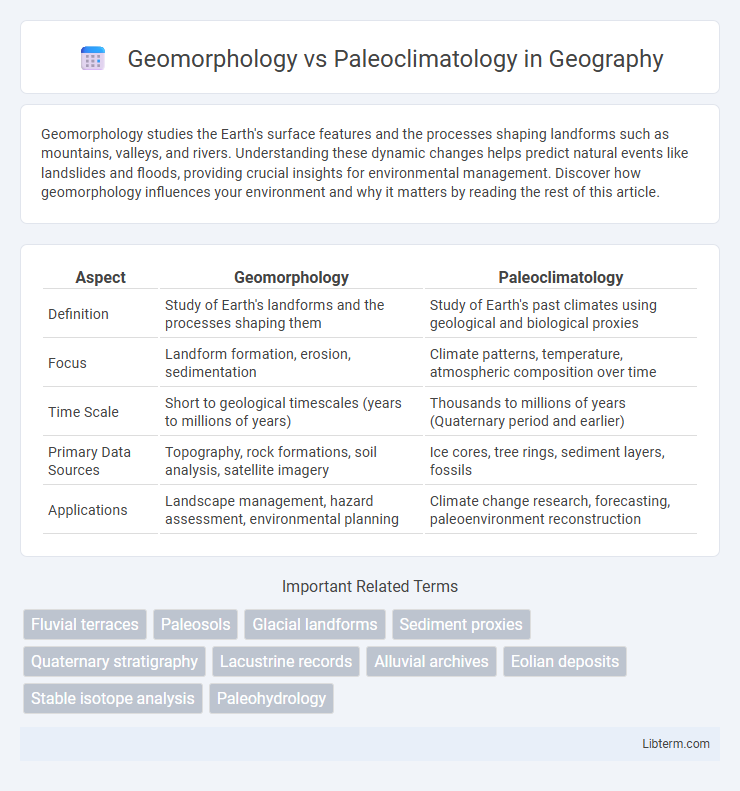Geomorphology studies the Earth's surface features and the processes shaping landforms such as mountains, valleys, and rivers. Understanding these dynamic changes helps predict natural events like landslides and floods, providing crucial insights for environmental management. Discover how geomorphology influences your environment and why it matters by reading the rest of this article.
Table of Comparison
| Aspect | Geomorphology | Paleoclimatology |
|---|---|---|
| Definition | Study of Earth's landforms and the processes shaping them | Study of Earth's past climates using geological and biological proxies |
| Focus | Landform formation, erosion, sedimentation | Climate patterns, temperature, atmospheric composition over time |
| Time Scale | Short to geological timescales (years to millions of years) | Thousands to millions of years (Quaternary period and earlier) |
| Primary Data Sources | Topography, rock formations, soil analysis, satellite imagery | Ice cores, tree rings, sediment layers, fossils |
| Applications | Landscape management, hazard assessment, environmental planning | Climate change research, forecasting, paleoenvironment reconstruction |
Introduction to Geomorphology and Paleoclimatology
Geomorphology explores the formation and evolution of Earth's landforms through processes like erosion, sedimentation, and tectonic activity, providing insights into landscape dynamics over geological timescales. Paleoclimatology reconstructs past climate conditions using proxy data such as ice cores, tree rings, and sediment layers, enabling understanding of historical climate variations and their impacts on global environments. Both disciplines intersect by analyzing how climate changes influence geomorphic processes, shaping the Earth's surface morphology throughout history.
Defining Geomorphology: Scope and Methods
Geomorphology studies landforms, their origin, evolution, and spatial distribution by analyzing processes like erosion, sedimentation, and tectonic activity. Techniques include field surveys, remote sensing, GIS mapping, and sediment analysis to understand Earth's surface dynamics. By integrating quantitative methods and qualitative observations, geomorphologists reconstruct landscape development and interpret environmental changes over time.
Understanding Paleoclimatology: A Historical Perspective
Understanding paleoclimatology involves analyzing geological and biological proxies such as ice cores, sediment layers, and fossil records to reconstruct Earth's past climates and atmospheric conditions. Unlike geomorphology, which examines landform processes and landscapes, paleoclimatology specifically focuses on historical climate patterns and their drivers over geological time scales. This historical perspective helps predict future climate changes by providing context on natural climate variability and anthropogenic impacts.
Key Differences Between Geomorphology and Paleoclimatology
Geomorphology studies the formation, structure, and evolution of landforms on Earth's surface, emphasizing processes like erosion, sedimentation, and tectonic activity. Paleoclimatology investigates past climate changes using data from ice cores, tree rings, and sediment records, aiming to understand historical atmospheric conditions and their influence on Earth's systems. The key difference lies in geomorphology's focus on physical landscape features and processes, while paleoclimatology centers on reconstructing and analyzing ancient climate patterns and their long-term impacts.
Interdisciplinary Connections in Earth Sciences
Geomorphology and paleoclimatology intersect through their shared focus on Earth's surface processes and historical climate patterns, enabling comprehensive analyses of landscape evolution influenced by past climate changes. Geomorphological studies utilize paleoclimatic data to reconstruct ancient environmental conditions, while paleoclimatology leverages terrain analysis to interpret sedimentary records and glacial landforms. This interdisciplinary connection advances understanding of climate-driven geomorphic dynamics and supports predictive models in Earth system science.
Methods of Studying Landforms vs. Past Climates
Geomorphology employs field surveys, remote sensing, and GIS to analyze landform structures and processes shaping Earth's surface. Paleoclimatology utilizes ice cores, tree rings, sediment layers, and isotopic analysis to reconstruct past climate conditions and variations. Both disciplines integrate dating techniques such as radiocarbon dating and luminescence dating to establish timelines for landform development and climate changes.
Data Sources: Rocks, Fossils, Ice Cores, and More
Geomorphology relies heavily on rocks, sediment layers, and landforms to interpret Earth's surface processes and history, while paleoclimatology primarily uses ice cores, tree rings, and fossils to reconstruct past climate conditions. Rocks provide geomorphologists with evidence of erosion, weathering, and tectonic activity, whereas fossils and ice cores offer paleoclimatologists detailed records of temperature fluctuations, atmospheric composition, and biotic responses over geological timescales. Both fields integrate multidisciplinary data sources such as sediment cores, isotopic analysis, and radiometric dating to build comprehensive models of Earth's environmental evolution.
Applications: Modern Relevance in Environmental Science
Geomorphology's applications in environmental science include landscape management, natural hazard assessment, and soil conservation, directly influencing sustainable land use and climate resilience strategies. Paleoclimatology provides critical data on past climate variations through proxy records, aiding in the modeling of future climate scenarios and informing policy decisions on climate adaptation. Integrating geomorphological insights with paleoclimatic data enhances ecosystem restoration efforts and improves predictions of environmental change impacts.
Challenges in Geomorphological and Paleoclimatological Research
Challenges in geomorphological research include accurately interpreting landform evolution due to complex interactions between tectonic activity, climate variations, and human influence, which often obscure the underlying processes. Paleoclimatology faces difficulties in reconstructing past climates because of limited proxy data resolution, spatial coverage gaps, and uncertainties in dating methods that affect the reliability of climate models. Both disciplines require integrating multidisciplinary data and advanced analytical techniques to resolve ambiguities in temporal and spatial environmental changes.
Future Directions and Emerging Technologies
Future directions in geomorphology emphasize the integration of high-resolution remote sensing technologies, such as LiDAR and UAV-based photogrammetry, to analyze landscape dynamics under changing climate conditions. Paleoclimatology is advancing through the application of isotopic analysis and sediment core imaging combined with machine learning algorithms to reconstruct past climate variations with greater precision. Emerging technologies like AI-driven data modeling and real-time environmental monitoring sensors are poised to transform both fields by enhancing predictive capabilities and fostering interdisciplinary research.
Geomorphology Infographic

 libterm.com
libterm.com